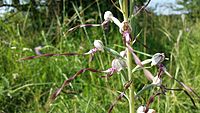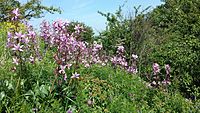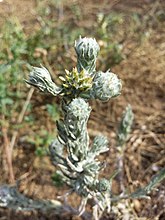Old Schanzen (Stammersdorf)

The old ski jumps in Stammersdorf in Vienna are former defenses and today remarkable natural monuments.
Geography and geology
The old ski jumps are located in the 21st Viennese district of Floridsdorf on the northeastern edge of Vienna between Brünner and Hagenbrunner Straße. In total, they have an area of around 9.5 hectares and are located on a gently undulating ridge at around 220 meters above sea level. The surrounding agricultural areas are considered difficult to cultivate. In the south is the wooded Herrenholz, after which the terrain slopes down over vineyards to Stammersdorf. In the west is the Bisamberg , in the east and north, clearly separated by a stepped terrain, the intensively agriculturally used Marchfeld .
Geologically, the ski jumps belong to the Laaerberg terrace , the highest and oldest glacial river terrace in the Vienna area. Their gravel occasionally comes to light in shallow fields in the area. The soils in the area are fertile Chernoseme .
history
The entrenchments were built during the Austro-Prussian War in 1866 as a defense system to secure Vienna against the Prussian troops advancing from the Marchfeld. For this purpose, the topsoil in the central area of the ski jumping hills was removed and trenches were dug around the facilities. The resulting material was used to build up walls. 31 jumps were built, the defensive belt stretched from Langenzersdorf , over the Bisamberg and the Alte Schanzen, Leopoldau , Kagran , Hirschstetten , Aspern to what was then the island of Lobau . The structures were numbered consecutively, the four ski jumps treated here bear the numbers X to XIII. All available labor, including women, children and the elderly, were requisitioned to build the fortifications. The defense works were manned by a total of 260 guns and 5000 soldiers. However, they were not used because an armistice was signed and the Prussian troops came to a halt on the Russbach .
At the beginning of the First World War , the old entrenchments were reactivated and, as part of the Vienna bridgehead, were supposed to protect the city from a possible Russian attack. After the Russian troops were stopped in the Carpathian Mountains , the defenses were not used this time either.
During the Second World War , anti-aircraft cannon positions were built on some entrenchments . A building was erected on Schanze X, the ruins of which are still in existence. In the nearby Herrenholz there was a repair shop for aircraft engines. During the last weeks of the war the front line reached the area and fighting between German troops and the advancing Red Army took place on the old entrenchments .
On June 5, 1981, jumps X to XIII were protected as a natural monument under the number 695 . Since December 2004, plants X to XII have also been located in the approx. 340 hectare European protected area Bisamberg.
Between 1993 and 1996 a water tank was built by the Vienna Waterworks between Schanze XI and XIII .
nature
Today the jumps are four distinctive, strongly reliefed dry and semi-dry lawns . The climate is characterized by dryness, warmth and exposure to wind, which contributes to the Pannonian flora of the ski jumps. Due to the terrain, it was not possible to cultivate arable land on the hilltops, which is why their flora was preserved. Until the end of the 1970s, the jumps were grazed and kept free of trees. After the end of grazing, bush encroachment began to a greater or lesser extent. In terms of plant sociology, the following units occur: continental dry grassland in the centers of jumps XI and XII, subcontinental semi-dry grassland on dry, permeable Chernosemas and framing tendencies in the peripheral areas, (sub-) xerophilic blood cranesbill fringing societies and, as a pre -forest stage, downy oak-bush forest . The fields around the ski jumps have an interesting Segetal flora (e.g. black cumin ).
Schanze X ( 48 ° 19 ′ 13.6 ″ N , 16 ° 24 ′ 58.4 ″ E ) is the most north-westerly structure and has an area of around 3 hectares and consists largely of subcontinental semi-arid grassland. Species of dry grass grow on the ruins of the ruins. The occurrence of the rare Adriatic strap tongue is also remarkable .
Hill XI ( 48 ° 19 ′ 15 ″ N , 16 ° 25 ′ 16.9 ″ E ) is the largest with 4 hectares and is located in the northeast. The central area consists of a continental dry grassland created by erosion. Typical species that occur here are the cranesbill , diptame , clematis , spring adonis , sand cinquefoil , narrow-flowered grape hyacinth , pasque flower , yellow leek and multicolored donkey .
Schanze XII ( 48 ° 18 ′ 59.6 ″ N , 16 ° 25 ′ 8.3 ″ E ) is 1.3 hectares in size, has a strong relief and is small-scale - u. a. divided into continental dry grasslands. Plant species worth mentioning include a. Mild stonecrop , dwarf yellow star and iris .
Schanze XIII ( 48 ° 18 ′ 49.5 ″ N , 16 ° 25 ′ 31.2 ″ E ) is located in the southeast near Brünnerstrasse, has an area of 1.1 hectares and is already heavily forested or covered with bushes.
The Alte Schanzen are home to a large number of endangered or endangered species and are accordingly important and worthy of protection. Around 360 vascular plants were recorded, of which 62 are endangered, 10 are critically endangered and two are critically endangered. From a faunistic point of view, the Alte Schanzen and the Bisamberg are also unique: 731 species of butterflies , 393 species of bees and 347 species of bugs were recorded and are intended to represent the high level of diversity here.
The jumps are part of the Bisamberg Natura 2000 area and are also individually designated as natural monuments . Habitat types 6210 "Near-natural lime dry grassland", 6240 "Sub-Pannonian steppe dry grassland" and 6250 "Pannonian steppe dry grassland on loess" according to the Habitats Directive Annex I come into play. A well-known FFH animal species in the area is the European ground squirrel . Nevertheless, until recently there has been a loss of area due to the surrounding cultivation. Since 2007, individual areas have been grazed with goats by the City of Vienna in order to prevent encroachment.
Adria tongue on movement X
Purple Mullein on Plant XI
Digging Plant XI with Diptam
Multi-colored iris on plant XII
Common feltwort in a vineyard between the entrenchments
literature
- Heinz Wiesbauer, Herbert Zettel, Manfred A. Fischer, Rudolf Maier (eds.): The Bisamberg and the Old Schanzen, variety on the edge of the city of Vienna , St. Pölten 2011, ISBN 3-901542-34-5
Web links
Individual evidence
- ↑ a b c d e f g h i j Barbara Becker, Susanne Leputsch: Vegetation and flora of the old hills , in: Heinz Wiesbauer, Herbert Zettel, Manfred A. Fischer, Rudolf Maier (eds.): The Bisamberg and the old hills , Diversity on the outskirts of the city of Vienna , St. Pölten 2011
- ↑ Entry “Preussian-Austrian War” in: Raimund Hinkel, Kurt Landsmann: Floridsdorf from AZ, The 21 District in 1,000 Keywords , Vienna 1997, ISBN 3-85447-724-4
- ^ A b Rudolf Maier: The Bisamberg - nature island on the edge of a megacity , in: Amerding D. (Ed.): Natural Heritage: Native orchids in Austria and Germany. 1st symposium in Austria on domestic orchids. Selected lectures , Austrian Orchid Protection Network 2009 Archive link ( Memento from March 4, 2016 in the Internet Archive ) (PDF; 1.3 MB)
- ↑ Natural monument 4 "Schanzen"
- ↑ European protected area - Bisamberg (Vienna part)
- ↑ Erich Hübl, Rudolf Maier, Barbara Becker and Manfred A. Fischer: Table 1: List of vascular plant species of the Bisamberg and the Alte Schanzen , in: Vegetation and flora of the Alte Schanzen , in: Heinz Wiesbauer, Herbert Zettel, Manfred A. Fischer, Rudolf Maier (Ed.): The Bisamberg and the Old Schanzen, variety on the edge of the city of Vienna , St. Pölten 2011
- ↑ Heinz Zettel and Heinz Wiesbauer: Wild bees (Apidae) as well as the introduction in: Heinz Wiesbauer, Herbert Zettel, Manfred A. Fischer, Rudolf Maier (eds.): The Bisamberg and the Old Schanzen, variety on the edge of the city of Vienna , St. Pölten 2011
Coordinates: 48 ° 18 ′ 59.6 " N , 16 ° 25 ′ 8.3" E






